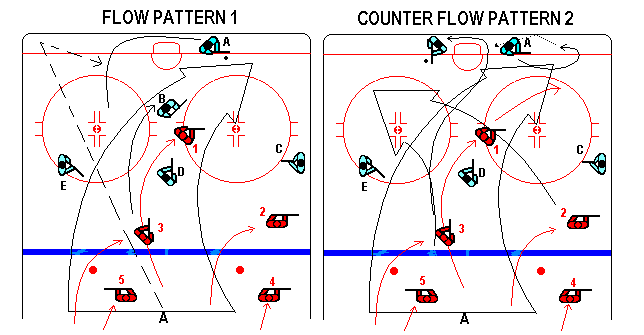

by Coach K, AllHabs.net
SAINT-LAZARE, QC.– Forechecking and applying puck pressure have become an integral part of today’s game of hockey. The ability to apply a proper forechecking scheme in a given situation often dictates wins and losses for teams.
The most commonly used forechecking system is the 1-2-2. In this scheme, the forward closest to the puck (referenced hereafter as F1) is to apply immediate puck pressure on the opposing puck carrier. If the puck carrier maintains possession of the puck, F1 is to engage body contact, in an attempt to separate the opposition player from the puck.
The two trailing players (who we will reference as F2 and F3) have a more difficult task. After determining the strong side, F2 takes a support position, and enters the play in an effort to take possession of the puck, dislodged by F1. F3 must maintain a position mid-ice, cutting off the weak side passing lanes. In this regard, the two remaining players, normally your defensemen, support F3 in his role.
While the 1-2-2 is a very passive strategy, it is necessary in today’s NHL. With the removal of the centre red line, this system covers the strong side, as well as most of the neutral zone. This limits your opponent’s options and, more often than not when executed correctly, results in a change in puck possession.
Another forechecking strategy is the 2-1-2 with a wide rim. In this scheme, after having dumped the puck into the offensive zone, F1 and F2 both apply immediate puck pressure from both sides of the puck carrier, while F3 plays a supporting role. Again, the two defensemen support F3, but instead of being in the neutral zone, they station themselves on the opposing blue line, applying even more pressure on the opposition’s defense. This idea is similar to the full-court press, used in basketball to get quick possession of the ball. The 2-1-2 is a high-risk, high-reward strategy, and is employed by teams who are normally trailing in a hockey game, with limited time left in regulation.

So what makes a good forechecker? Normally, offensively gifted players are ideal candidates, because of their ability to read and react to given situations. This is the case with players like Tomas Plekanec. Although small in stature, his above-average hockey sense gives him the ability to quickly determine which side the opposing team’s breakout is using, and apply the necessary puck pressure. Once he positions himself on the forecheck, his teammates can then follow suit, and give him the necessary support to be successful in regaining the puck. Other players who were better known for their offensive prowess, but were excellent forecheckers were Doug Gilmour and Wayne Gretzky. While they are both recognized more for their offensive contributions during their playing careers, their ability to apply a strong forecheck and separate opposing players from the puck was a big part of their impressive offensive numbers.
The 1-2-2 is the current forechecking system used by Jacques Martin’s Montreal Canadiens. However, there are certain extra elements required by the current Habs’ roster to make this system work more effectively. The primary deficiency is the Canadiens’ unwillingness to finish their checks. On many occasions, you can see their physically challenged forwards apply pressure on the puck, but veer off before body contact should be engaged.
Another key element is the Canadiens’ ability to read the breakout and apply puck pressure on the proper side. In many instances, Canadiens’ forechecker apply pressure from the strong side boards, and try to force their opponents into the mid-ice lane. While this idea is not without merit, since in the 1-2-2 the neutral zone is saturated with defensive players, some skilled opposition players will fake inward and continue along the boards, thus confusing the defensive coverage and cause subsequent breakdowns.
So is the forecheck an offensive or defensive strategy?
By definition, a team that is not in possession of the puck is on defense. And being on offense is the opposite. When talking about forechecking, it depends on the strategy. The 1-2-2, since passive by design, is more of a defensive scheme. This is the reason may teams are deemed to be defensive by nature. The 2-1-2, with its immediate two-player puck pressure, is an offensive scheme. Teams like the Tampa Bay Lightening strictly uses to 2-1-2, and are deemed offensive, not only because of their obvious offensive talent, but because of their relentless pursuit of the puck.
(Featured diagram courtesy of hockeyschoolonline.net)